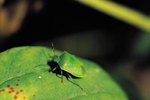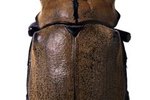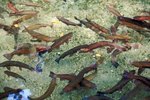
The Hercules beetle (Dynastes hercules) is found in Central and South America, from Mexico to Bolivia. True to their name, these beetles are among the largest and strongest in the world—they're capable of carrying up to 850 times their own body weight. Various adaptations allow these beetles to thrive in their native environment.
On the Horn
When looking at Hercules beetles, you won't miss their large pair of horns. These horns can even be longer than the bodies of the beetles themselves—in excess of 7 inches. Their upper horn is known as the thoracic horn and their lower the cephalic horn. They're able to move their cephalic horns up to meet their thoracic horns, so they act much like large pincers. Only males of the species have these horns, and they use them to fight other males for mates and food. Lacking any horns, females avoid fighting altogether.
The Bigger the Better
With a maximum body length of nearly 7 inches, Hercules beetles certainly couldn't be described as diminutive. Their large size gives them a distinct advantage over other insects and beetles, as they're too big for many potential predators to tackle. Although their bulk allows them to avoid predation from many creatures, they can still end up as dinner for larger birds, reptiles and mammals.
Changing Colors
While Hercules beetles' forewings (or elytra) are usually a yellow-green color, they're able to rapidly change their color to black. They have thin, spongy layers under the outermost layer of their exoskeletons (the epicuticle) that can take on fluids and cause this color change, which occurs only when humidity levels reach over 80 percent. The evolutionary advantage of this adaptation has not yet been discovered, but it may help to camouflage these beetles or be related to their thermoregulation.
Dig This!
Although Hercules beetles eat a range of different foods, including fruits and other plant matter, what they like to feed on most of all is rotting wood. To be able to get to it, they must be able to dig and burrow their way through rotting trees and branches. These beetles have adapted to have spines on their legs, which they can use to help them dig into these materials.
References
Photo Credits
-
Hemera Technologies/PhotoObjects.net/Getty Images




